John Moses Browning was a genius — which is kinda like saying water is wet or snow is cold. It’s so blindingly self-evident, it really doesn’t need to be said. The operating mechanisms of his designs were revolutionary in their time, and continue to be used in modern firearm design today. Some of his masterworks continue unchanged (like the 1911 handgun), and others live on in the derivative designs of others. The Browning Automatic Rifle is one of those quintessential Browning designs that not only proved to be indispensable to soldiers in its day, but whose operating components would go on to form the basis for the main battle rifles still in use by some European countries in the 21st century. OK, so on with a little history lesson . . .
With World War I in full swing, the need for a lightweight, man-portable machine gun was becoming more and more critical. Browning had already designed one of the primary machine guns being used by the U.S. and allied forces (specifically, the M1895 Colt-Browning “Potato Digger”), but even that chunky, awkward tripod-mounted monstrosity was a svelte Swedish supermodel compared to the Vickers and Maxim machine guns that were the staple of the French trenches.
Machine guns were considered to be in the same category as a mortar crew or artillery battery, namely a fixed asset that was placed on the battlefield and then never moved. But when one attack after another broke through the enemy lines and then failed to hold the ground, they gained due to a lack of firepower, the generals decided that they needed a machine gun that could move with the troops as they advanced.
The Maxim gun weighed close to 60 pounds without ammo and water. It wasn’t going anywhere anytime fast, and generals needed something better. To that end, John Browning came up with two designs. The first was an air-cooled heavy machine gun, revolutionary in that it didn’t require a heavy water jacket and a constant stream of cold water to keep it functioning — the volume of water required for such a gun bogged down MG crews of the day.
The second design was the 16-pound Browning Automatic Rifle, a select fire rifle capable of being carried by a single soldier and deployed at a moment’s notice. It was the first firearm to fit the traditional definition of an “assault rifle.”
When Browning wanted to show his new designs off to the government, he organized a live fire demonstration in the heart of Washington, D.C. one cold February morning and invited congressmen and Army officials to witness his new machines. They were so impressed with the designs that Browning was awarded a contract to produce the guns for the military on the spot.
While other guns like the Thompson SMG would be introduced too late in the war to be distributed on the front lines, the Browning Automatic Rifle (officially designated the “Rifle, Caliber .30, Automatic, Browning, M1918”) not only found its way to the American trenches but was credited as being a pivotal piece of equipment in one of the last battles of the war. Not only did it help the Allies, but one of the rifles was issued to John Browning’s son Val who was serving in the American infantry in France and demonstrated its abilities in action. The rifle impressed the troops and officers on the ground as much – if not more than – the politicians on that cold February morning, and the BAR was here to stay.
Between the wars, the BAR was sold to civilians and law enforcement alike. However, unlike the Thompson SMG it wasn’t used in significant quantities by mobsters and so never truly gained the same notoriety that its smaller cousin achieved.
While the BAR wasn’t in service long enough to make a significant dent in the Great War, it was downright pervasive in the big one. The Browning Automatic Rifle was issued as a squad level machine gun, meaning that small units now had the ability to form an effective base of fire while maneuvering and attacking the enemy. It gave the soldiers of WWII an advantage that they desperately needed in the previous war, and proved to be an extremely effective firearm. The BAR was so effective that it was still in active use when the Vietnam war heated up.
The eventual downfall of the BAR was its weight and cartridge choice. JMB chose the .30-06 Springfield cartridge for his gun because that was the primary caliber of choice for the U.S. soldiers in their M1903 Springfield rifles. Ammunition compatibility between the squad level guns meant that soldiers in the field could share ammo between each other when supplies started running low.
But while the .30-06 cartridge is a great round for killing enemy soldiers, it’s an extremely heavy and bulky cartridge. The largest magazine issued to the BAR crews was a 30-round magazine, and then only in anti-aircraft functions. Twenty-round magazines the size of waffles were the standard loadout, and the small capacity magazine combined with the heavy ammunition was just too much to carry. In addition, in order to fire that heavy and powerful ammunition, the gun needed to be over-engineered to take the strain of full-auto .30-06. That over-engineering led to a rifle that’s extremely overweight by today’s standards.
Sometime during the Vietnam War, the BAR was quietly replaced by the M60 machine gun. And the M60 was eventually replaced by the M240 and M249 series of squad-level machine guns. But for nearly 50 years, the BAR reigned supreme on the battlefield. And when you pick one up, you understand why.
Thanks to Kevin Brittingham, I had a chance to spend some quality time with a M1918A2 Browning Automatic Rifle recently. This improved version featured a bipod and a hinged buttplate as well as two rates of automatic fire to make the gun more manageable in full-auto mode and was in service starting around 1938 through to the end of the war.
The first thing you notice about the rifle is how goddamned big and heavy the thing is.
The BAR is not a small object. The barrel on the rifle is a good 24 inches, and the receiver adds even more length to the gun. All told, it’s damn near as big as my friend here. From simply toting it around a firing range for an hour, I have absolutely no idea how my forefathers lugged this thing across Europe.
While the gun is chunky, the weight also renders the recoil very manageable and makes the thing nearly indestructible. The gun was manufactured with the idea that it would see some heavy usage, and as a result the over-engineered parts of the gun are MASSIVE. The trigger alone on this gun is even chunkier than the bangswitch on SCAR rifles.
While the gun is big, the ergonomics are excellent. The carrying handle is perfectly placed such that the gun is balanced in the operator’s hand when being carried. And when in the firing position, the BAR handles like any other rifle of the time. The stock is perfectly shaped to give the shooter a good cheek weld and the handguard features a comfortable curve to fit your palm. The only ergonomic gripe I have about the gun is that the hinged buttplate doesn’t really work very well, but it doesn’t seem like very many people actually used it and the gun works just fine without it.
The bipod, however, is another story. This piece of kit comes from a time when bipods were still a new idea and it shows. Instead of the spring-loaded contraptions we have these days, the BAR’s bipod is deployed by fiddling with a series of wingnuts. It ain’t quick, and it definitely isn’t pretty. Still, it works.
Among the interesting features introduced on the firearm is the inclusion of a non-reciprocating charging handle, something other makers still haven’t quite grasped a century later. The charging handle also features a nicely curved knob, but it doesn’t give the shooter quite enough to hold onto in my opinion. During our session, we had a situation where I fired a burst and the gun jammed slightly out of battery with a round in the chamber. We tried the usual tricks, namely bashing the butt of the gun on the ground while pulling the handle, but there wasn’t enough to grab in order to get the leverage we needed. Eventually a screwdriver was employed to remove the malformed round (lovely Israeli surplus stuff, slightly corroded), but it showed a weakness in the design that could be deadly on the battlefield.
While we’re on this side of the gun, there are two more things I’d like to point out. First are the takedown pins on the side of the receiver which are held in place by some dimples in the metal. Swiveling those takedown pins allows the trigger group and handguard to slide free, leading to a quick and easy field strip, should the need arise. However, disassembling the gun any further is an absolute nightmare. I’ve seen it done once and I don’t want to try it.
One of the more interesting features of the A2 is that it came with two rates of fire, a “slow” and “fast” full-auto mode. A single selector switch allowed the gun to move from “safe” to either of those modes and there was an interesting addition of a pin that popped out and kept the selector from moving either off safe or onto safe by accident. In order to take the gun off safe, you need to depress that pin first. it’s an interesting addition and one definitely well thought-out for battlefield usage.
Also of note is the magazine release. The button to release the magazine was housed inside the trigger guard, on the side closest to the magazine. If it were introduced today, there’s no doubt that placing the magazine release inside the trigger guard would ruffle some feathers. But that’s where Browning put it and it made sense given how the magazine catch mechanism works.
Enough stalling, though, let’s talk about the operating mechanism.
There were many firearms to use a tilting breech locking mechanism prior to the BAR, but this gun brought it to a whole new level.
The gun fired from an open bolt (to keep the parts simple and allow air to circulate and cool the barrel), meaning that the firing pin was fixed and impacted the primer as soon as the breech was closed. But while the Thompson SMG could simply use a friction-delayed straight blowback design, the raw power of the .30-06 cartridge meant that the breech needed to remain closed until the bullet was well down the barrel and the chamber pressure had dropped.To keep the chamber closed, Browning adapted a tilting breech block system to keep the bolt closed until the conditions were right.
If you look closely at the bolt, you’ll notice what looks like a cam about halfway down the side of the bolt. This cam is attached to a piece of metal that rises up into the hump just to the rear of the ejection port and locks the bolt in place. After the bolt is locked, the force of the pressure in the barrel can no longer force it open again. You can see this movement very clearly in the slow motion part of the video, above. Interesting side note: this action eventually developed into the operating system for the FN FAL which has been called the right hand of the free world and is one of the most-produced firearms in history.
So that locked the breach, but there was a problem. The gun needed a second system to sense when it was safe to move the bolt backwards and to provide the power to cycle the action.
To make that happen, Browning adapted the gas system from the Colt-Browning machine gun to be a closed system instead of the open, trench-digging abomination that was his first attempt. The closed system used a long-stroke piston to cycle the action, pushing it all the way to the back of the receiver before allowing the bolt to move forward. It was one of the first times that such a gas system had been designed, and the success of the gun was so great that John C. Garand copied the idea for his M1 Garand rifle. The BAR was also one of the first guns to have an adjustable gas system that could be tuned to decrease the wear on the gun from heavier loads of ammunition and make the gun cycle properly even in adverse conditions.
While the gun was designed for a suppressing fire role, it came equipped with some killer sights, too. The ladder sights used on the gun are calibrated in hundreds of yards, with markings out as far as 1,500 yards. The shooter could choose to use the gun while looking down a peep sight or he could lay the ladder down along the receiver and use a notch cut in the top as a rear sight instead.
When firing, even with the weight of the gun and the gas operating system, the gun doesn’t want to stay on target for more than three rounds. The trigger is very heavy and while the first shot always seems to be on target the subsequent two don’t seem to land anywhere close. It makes the gun great for suppressing fire (where the object is simply to keep the enemy’s heads down while you advance), but for hitting targets at distance, it doesn’t seem all that useful. The recoil is simply too heavy to keep it on target for any period of time.
While the gun is heavy and hard to control, there’s no doubt that it is absolutely beautiful. The sleek lines of the receiver are stunning and the original parkerized finish is soft to the touch. It’s a work of ballistic art, for sure. And one that won WWII.
Browning Automatic Rifle
Specifications
Caliber: .30-06 Sprg.
Barrel: 24″
Size: 42″
Weight: 16 lbs. empty
Operation: Long stroke gas piston
Capacity: 20 / 30 round box magazine
MSRP: around $10,000
Ratings (Out of Five Stars):
All ratings are relative compared to the other weapons in the gun’s category.
Accuracy: * *
First round always seems to find the target. After that all bets are off.
Ergonomics: * *
Heavy. Big. Uncomfortable shoulder thing that goes up. In short, not at all ergonomic.
Ergonomics Firing: * * * *
Recoil is pleasant, but the trigger is a touch heavy.
Customization: N/A
No. Just no.
Overall Rating: * * *
There’s no doubt that the BAR is a work of art, both aesthetically and mechanically. But there’s no way I’d want to carry this thing around a battlefield.

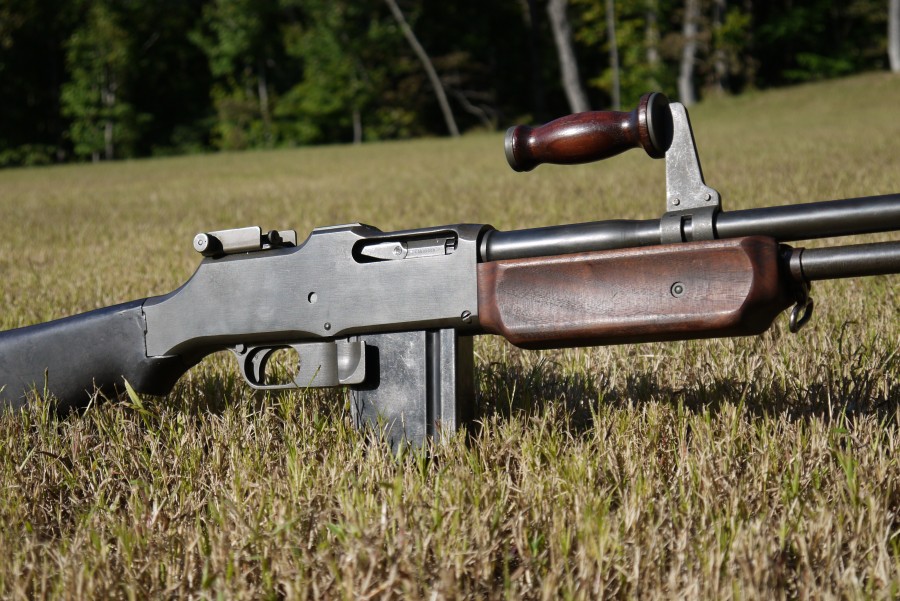

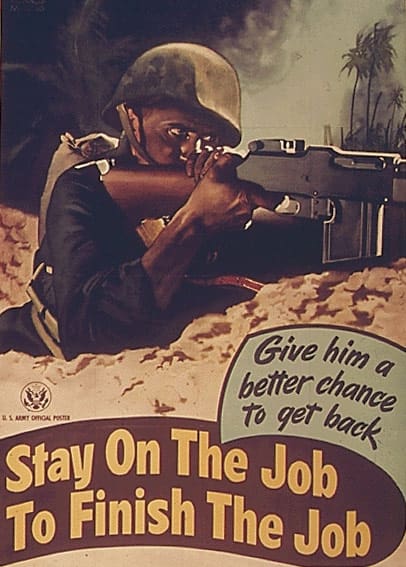
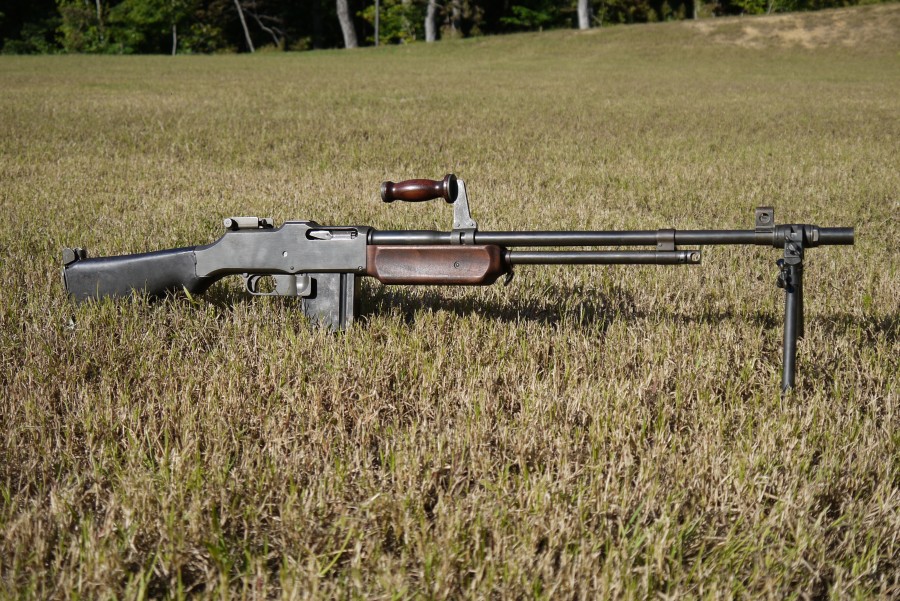

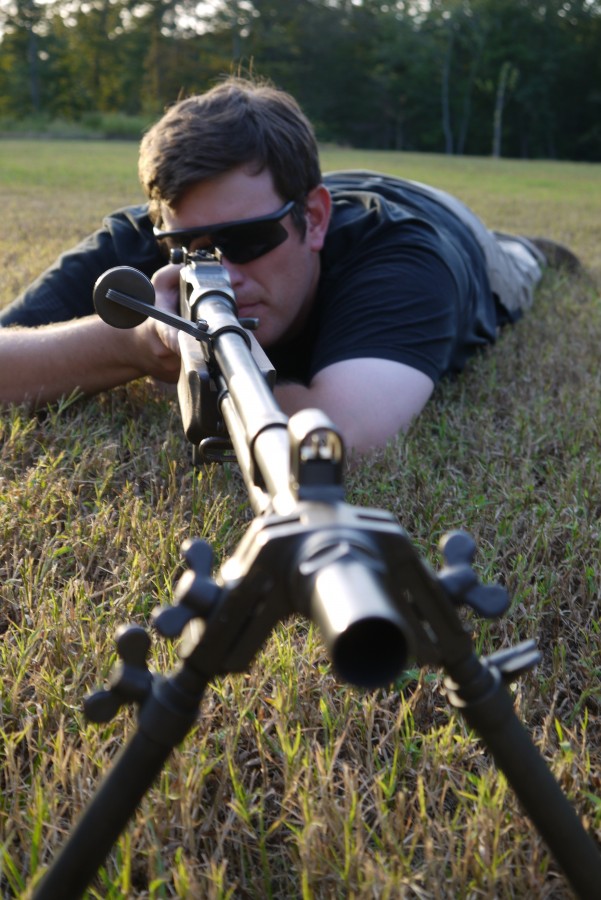
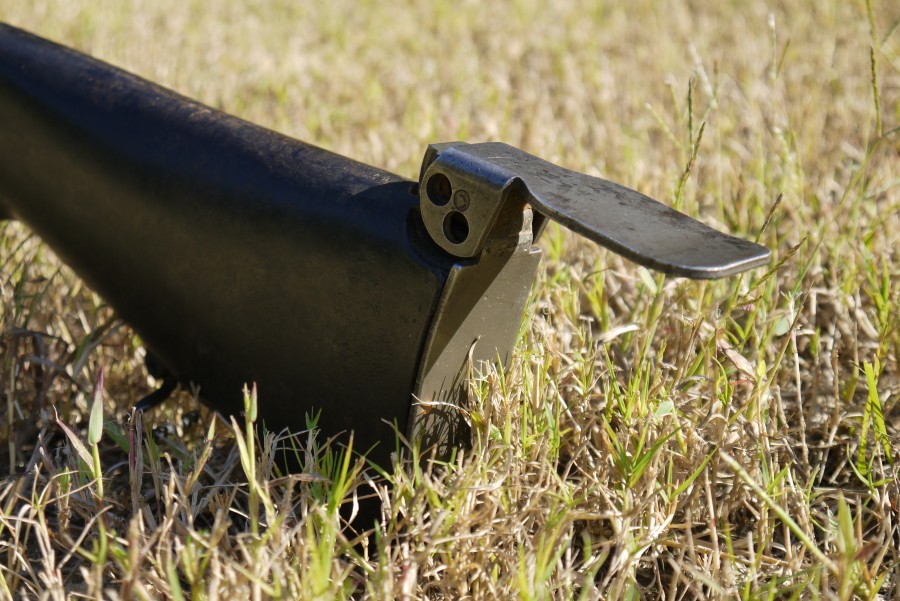
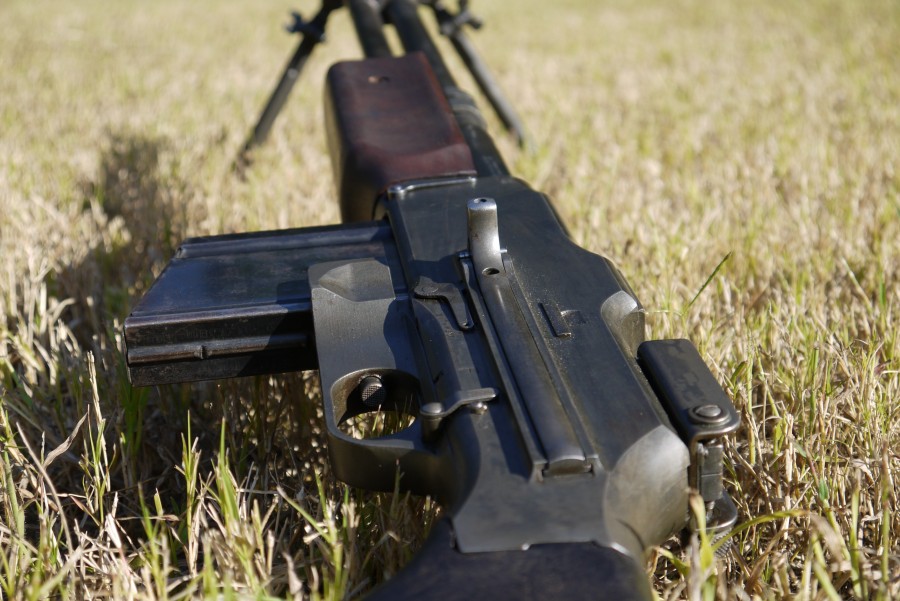
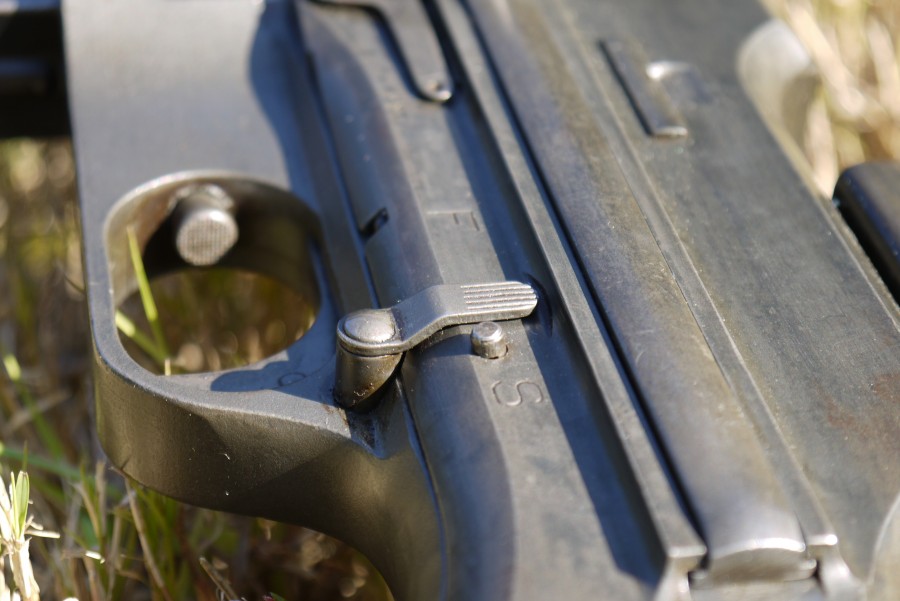
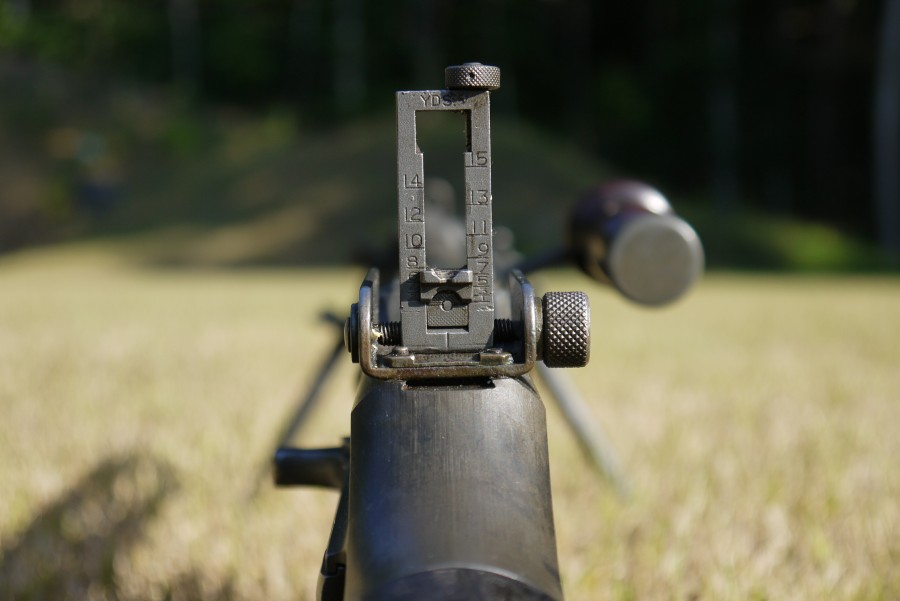



Enjoying the hell out of these ‘retro-reviews’. Especially seeing Great War arms in full-color action. Integrating Forgotten Weapons is a stellar idea as well.
Please keep ’em both coming.
+1
Agreed. These retro reviews are awesome! Makes me think of my grandpa and the “Greatest Generations”. Those guys must have had arms of steel to lug around the gear they had back then.
Those old guys were tuff and I take my hat off to them. Having said that, I don’t knock the grit of the young guys either. Between their body armor, which wasn’t an issue in the Big War and all the other crap they have to load out with it ain’t a job for p*ssies. Regardless of generation.
Truth. 30+lbs of body armor, and an M249 SAW weighs more than a BAR. I love hearing people talking about how important it is to have a 6lb mountain rifle instead of a 7.5lb one. Try a 22lb mg in the mountains in Afghanistan.
Ditto here. Excellent and Fun reading.
But there’s no way I’d want to carry this thing around a battlefield.
Fair enough in the context of today’s battlefields, but if I were in the trenches of WW1, my reaction would be, “Gimme!”. After all, what would be the alternative…a Chauchat (shudder)?
Even in the context of WWII, I’d rather have an M1 Garand or a Thompson SMG before I picked one of these things up. I’d happily trade either rate of fire or effective range for something a little lighter and more controllable.
I probably wouldn’t want to carry one myself either, but you can bet I’d want one (or two or three!) in my squad.
“Reiben, where’s your BAR!”
“The bottom of the channel, sir, the bitch tried to drown me.”
Great review for a great gun. Is anybody making civi semi-auto versions these days?
Ohio Ordinance makes one you can buy today. About $4000 if I recall.
Two of them for sale at Gunbroker as I type this. Alas, I don’t have $4500 burning a hole in my pocket…
Many thanks! Had been saving to put together a nice M1A this year…but damn one of these babies would look good in the safe.
I had a discussion with a senior NCO about wood versus synthetic stocks for hunting rifles. When I told him that our fathers managed quite well with 9lb rifles he said “that’s because they were men and we are pussies.”
A Lewis in WW I. A Bren in WW II.
Sorry, but the USA has not been the best for LMGs
I was under the impression that the Lewis was an American design.
The Lewis gun was an american designed gun.
A very well designed gun.
Politics kept americans from using it.
The Thompson with a few mags was as heavy as a BAR and no where near as accurate. At 50 yards you would be better off with a pocket full of rocks…
I CARRIED A BAR THROUGH FIVE MAJOR CAMPAIGNS IN NORTH KOREA MAR 1951- FEB 1952.
SILVER STAR AND PURPLE HEART.
I AM KNOWN AS NICK THE BARMAN BY MY FELLOW MARINES. AS FAR AS I KNOW THAT MAY BE A RECORD. MOST FOLKS WITH A BAR QUICKLY HANDED IT OVER TO THE NEW REPLACEMENTS WHEN THEY GOT TO THE RIDGE LINE——-I LOVED TO SHOOT IT—–BUT IT DID ATTRACT A LOT OF INCOMING
I WROTE THE BOOK G- 3- SEVENTH MARINES (a brijef glimpse athrough time of a group of young marines) . WHICH WON THE GOLD MEDAL FOR THE BEST MILITARY HISTORY BOOK WRITTEN IN THE UNITED STATES ABOUT 4 YEARS AGO
THE BLURBS MAY BE REVIEWED ON AMAZON , FACEBOOK, BARNES & NOBLE, AND SEVERAL OTHER SITES
Saw a pic/poster. It had a picture of a U.S. G.I. w/ a Browning Automatic Rifle. The caption read:
So, Three Nazi’s Walk Into A BAR.
http://www.funnyjunk.com/funny_pictures/3703746/BAR/
“I bet they had a garand time”
mmmmgh
http://www.reactiongifs.com/wp-content/uploads/2013/07/data-s-s.gif
Great review. More of that good, legacy gun porn, please! Anyone else feel like channeling Will Smith from “Independence Day”… “I gotta get me one of these!”
Ditto.
Arguably not the best SAW/LMG of its time, but a pretty awesome gun nonetheless.
God bless JMB!
“Arguably not the best SAW/LMG of its time, but a pretty awesome gun nonetheless.”
Actually, it was the only squad automatic weapon (SAW) of it’s time.
In my recollection, the variable gas port wasn’t to shoot faster or slower. It’s primary purpose was to allow more gas pressure to operate the bolt when the thing got dirty.
Same as the M240/MAG-58 that is a derivative of the BAR
“However, unlike the Thompson SMG it wasn’t used in significant quantities by mobsters and so never truly gained the same notoriety that its smaller cousin achieved.”
Except that it was. The M1918 was a favorite Bonnie and Clyde. John Dillinger and company stole a few from the National Guard. The FBI used them in a couple of shootouts with the Gangsters and they were also issued to the Treasury. They were not nearly as popular with prohibition gangsters as they were for the 1930’s Bank robbers.
The BAR figured prominently in the killing of Bonnie & Clyde. They hosed that Ford down until it was swiss cheese.
One of the two FBI agents who killed Baby Face Nelson had a BAR. Final score: Nelson,2; FBI 1.
Nelson had 17 30’06 rounds in his body. But his Thompson got the agents.
Baby Face used a Colt Monitor machine gun not a Thompson in his final shootout. He faced down two FBI agents. One agent had a Thompson and the other used a shotgun. They hit him over ten times, but they didn’t get a kill shot in fast enough. He kept coming and won. It was an insane gunfight. He died from a stomach wound several hours after the battle.
And some people trust a 22LR to stop a home invader. A 22LR might stop him eventually, but he might do a lot of injury before he stops.
Yes, a picture of Bonnie and Clyde’s weapons at time of death included 2 BARs and 100 mags. No Tommy guns though.
http://en.wikipedia.org/wiki/File:BarrowDeathCarArsenal1934.jpg
I had to hump one of those weighty elephants during a night training session at Camp Drum some years ago. At 5’7″ and 145 lbs., I was not one happy camper at the end of the evening! Lovely gun, though.
There is a lot of talk of the weight of the gun part of its design shortcoming. At 16# it is still lighter than a SAW?
I think the complaining about the weight comes because it’s kinda an “in between” gun… Not really an automatic rifle and not really a machine gun…
If you compare to contemporary MGs it certainly was lighter than its counterparts, the BREN and MG42 were both over 20 pounds. It weighs more or less the same as the modern M249 SAW IIRC.
As far as I know it’s the only ww2 era weapon that had an entire episode of a popular tv drama devoted to it. 1 episode of “Combat!’ was given over to the importance of the BAR to an American infantry squad and how important it was to get the gun to the right soldier.
A couple of small points:
1. The water-cooled HMG’s of the day didn’t require a flow of cold water over their barrels. Their water jackets were filled before operation, and then a hose was used to pipe off the steam from the jacket as the barrel boiled off the water. This hose ran down into a field condenser, often half-buried in the ground, which would turn the steam back to water, which you’d use your “copious free time” to pour back into the water jacket upon occasion. This would also keep the steam rising off the gun from being spotted, because once spotted a HMG position became an artillery magnet.
2. The .30-06 is neither bulky, nor heavy. It’s just a canonical, full-powered rifle cartridge. It is no more or less heavy and bulky than any of the other rifle cartridges of its day, the 8×57, the 7.62x54R, or the .303. They’re all full-power .30+ cal rifle cartridges. The German machine guns of post WWI (the Mg34 and then the infamous Mg42) used the 8×57 cartridge. The way they got lighter and more portable than the 1917/1919 was to require frequent barrel change-outs to allow the barrel to cool whilst you hung on a new barrel. They were issued with spare barrels and asbestos mitt to allow you to grab hold of the hot barrel while you pulled it out of service.
Today, in keeping with our modern practice of deluding ourselves with marketing, we’ve taken it upon ourselves to attempt to turn a cartridge used for shooting squirrels, rabbits and coyotes into an infantry weapon cartridge. Our forefathers would laugh derisively at us. Matter of fact, most all the WWII, Korean and early Vietnam vets I’ve talked with about guns regularly do laugh with derision at the 5.56 cartridge. One of the most common terms I hear used is “poodle-shooting cartridge.” These old men don’t consider poodles to be real dogs, either.
The .30-06 came in lots more variants than just the 150gr ball. They had AP, tracers, incendiary, fragmenting, etc. You can disable a car easily with ’06 AP rounds. They’ll zip right through an engine block, so the choice of ’06 as the ammo was partly motivated by the fact that we didn’t yet have the Ma Deuce yet as an anti-material gun. Give a man with a BAR a dozen mags full of AP/incendiary ammo and a whole lot of trucks coming down the road are going to meet a death by fire.
3. The tactics of machine guns were very different in those days. Today, we talk of “suppression fire” and “fire and maneuver” – but those tactics were pioneered by the Wehrmacht in WWII. In WWI, the period when the BAR (and other) machine guns were developed, as you say, the guns were mostly static. But, the way they were used was to create “beaten zones” and they’d do the same thing with massed infantry fire. Look at the sights on a 1903 (not ’03A3, but a genuine 03) rifle. Same type of ladder sights. Same cartridge. Same tactic: Everyone set your ladder sights on “X” yards, aim at this particular area “over there” and start firing. The idea wasn’t to hit a particular person, it was area denial. The HMG’s of their day could control large areas of real estate on the battlefield. The BAR could leap out front and start controlling areas whilst waiting for the HMG’s and light artillery to catch up.
So the inaccuracy you see in the BAR after the first shot wasn’t a huge downside for them – they were still able to move that weapon forward on the field and create a “beaten zone” downrange, with one man being able to do the lead-launching of perhaps a half dozen men.
The Germans were way ahead of everyone in realizing the power of the machine gun as an area denial weapon in WWI. They used the Maxim to great effect, while the UK, French and (especially) the US were stumbling around, wondering how they were going to justify “wasting all this ammunition.” Go back and re-read the history of such horrible ideas as the Battle of the Somme, and how the complete morons who were installed as the UK military leadership marched the flower of their nation’s manhood into interlocking fields of fire of Maxims – to losses of 20K+ per day. If anyone wonders how the UK went from “masters of the world” to “world’s leading pussies” in a century, one need only read of how the UK military and political leadership went full-throttle retard in 1916.
Excellent summary, however, the pioneering infantry tactics originated in the First World War with the Strosstruppen (shock troops). Blitzkrieg was a philosophy that applied the tactics of the strosstruppen with mechanizatiion. The first writings on this doctrine can be found in a book called the Army of the Future (Vers l’Armée de Métier) by an obscure French Captain name de Gaulle.
The Germans had the ideal infantry squad organization. The machingun was the principle offense weapon protected by the rest of the squad. In most other armies the machinegun supported offensive action by the rifle squad. The Germans had the right idea but the wrong infantry weapon. The US Army had the other half of of equation worked out with M-1. For a short time Western Armies had the ideal offensive infantry squad organization. A mobile light machinegun supported by infantry with select fire but mainly semiautomatic battle rifles. The US Army trashed this more effective organizaiton in Vietnam when they replaced the M-14 with the M-16. You can make the argument that the M-16 was better suited for the Vietnam enviroment but it was poorly suited for every place else. Since you can’t maintain two seperate infantry rifles we had to choose one.
One of the initial tactics designated for the BAR was called “Walking Fire”- every time the operator’s right foot would take a step, a shot would be fired from the hip. A step on the road to “Volume of Fire” tactics, yet still rooted in older advancing infantry line tactics.
That was in WWI where linear tactics were the norm.
WWII infantry combat was very much unlike WWI. It took place in generally open position and at longer ranges so weapns like the Thompson had less of an impact than they would have in a trench warfare enviornment. Despite Nick’s enthusiasm for the Thompson US infantry units generally cleaned up on German units when they were equipped primarily with MP40s. They got cut down by a wall of aimed fire long before they could get close enought to be effective. Even then aimed fire from M1s shot them down. The Germans recognized this limitation and that is why they ended up designing the Sturmgewehr 44 to combine high volume fire with longer range. Submachine guns were as effective as Garand in a few niche environments.
Regarding .30-06 AP and engine blocks: The “Box O’ Truth” website tested it (and a number of other calibers as well) vs an engine block.
http://www.theboxotruth.com/docs/bot54_3.htm
The .30-06 M2 AP round did penetrate the near side of the engine as well as the cylinder wall, which would quickly disable the engine if it were running, but it didn’t exit out the other side. Still impressive, though.
The other results:
.357 Magnum: bounced off
.44 Magnum: hole in the side, didn’t penetrate the cylinder wall
5.56×45: hole in the side, didn’t penetrate the cylinder wall
12 Ga. slug: hole in the side, didn’t penetrate the cylinder wall
BAR really falls into that very small family of Machine Rifles. Not quite a light machine gun and not quite a battle rifle.
Fellow members being the Notorious Chauchat and the RPK. I’m thinking of others but mind not recalling at the moment.
They’re called “squad automatic weapons”. And I’m not sure I’d say that’s a very small family of weapons. Many modern assault and battle rifles have had a SAW variant:
1. AK -> RPK
2. FAL -> FALO
3. M14 -> M15 (albeit never produced)
4. AUG -> AUG HBAR
5. M16 -> too many to name, but HK416 comes to mind
Good point and a few that had slipped my mind. I guess I’d define a Machine Rifle as a heavy barreled version of a standard issue rifle like the RPK or FALO. Main point is the barrel is permanently attached thus limiting fire of the weapon. I suspect in that case the BAR falls more into a SAW than a machine rifle.
I know I wouldn’t mind having a BAR even with it’s faults.
Fantastic article.
And I’m jealous again.
Why again is a reciprocating charging handle bad? I like it. if anything goes wrong, you can control the location of the bolt. Besides, you gotta give the BAR one star for customization: black bakelite or wood, bipod or tripod, and semi/full, or slow/fast. 😀
“Why again is a reciprocating charging handle bad?”
It’s not.
In fact, I would say it is superior.
Correct me if I’m wrong, but in the poster, is that Obama firing a BAR?
Those who rave about the BAR never used a BREN!
It’s mostly true what you say but consider that your comparing the BAR to the BREN-One an automatic rifle with lighter magazines to a true light machinegun at approx. 30lbs. with heavily constructed mags mags and spare barrels make this weapon require help in transporting. The bren is an extremely well thought out design but the BAR makes a more portable one man weapon which even with its total load of ammo mags doesn’t tie down anyone else. Also in my humble opinion says that the .30-06 round is far superior to the .303 in range and hitting power.
“Those who rave about the BAR never used a BREN!”
The BREN was technically a crew (two people) served weapon.
The BAR was an individual weapon.
I’ve got a parts kit for one of these bad boys. I need to put it together with at least a dummy receiver by the time my daughter starts to date.
I wouldn’t disparage the Maxim, it was far more influential that the BAR could ever have been, it was however quite immobile. The BAR was perhaps the first practical SAW and it served the role better than anything else on the battlefield until after WWII. It was however heavily outclassed be the MG36 which would have been a devastating SAW had it been employed as such, a matter of tactics rather than functionality.
As for that charging handle, I believe the technique calls for hammering an empty casing over the knob to allow a full hand purchase for such sticky situations.
I’ve had the privilege of shooting a BAR many times while living in Phoenix. A friend has one plus a 1928 Thompson, I have a BM-59 a Sten and a MAC-10 so we often swapped out at the range. Heavy: a bit but it works every time. The range in Phoenix had an oxygen or acetylene bottle hanging out at 200 yards. I could fire 2-3 shot bursts off the bench and constantly ring the “gong” at 200 yards. Single shot at 300 yards I could group 5 shots in about 6″ not bad for high powered rifle firing from an open bolt. I would love to own one, when you start shooting almost everyone at the range stops and comes over to see just what is being shot. Very well made and designed for long term use I don’t thing any of our new wonder weapons would last as long. I was told by an old friend from Korea war times that when you’re being shot at you don’t notice the recoil or the weight while returning fire. His biggest gripe was the shortage of ammo in the 20 box magazines. Caliber wise my favorite is the .308 just cause it’s what the 30-06 basically turned into. The 168grn JHP work pretty well on deer and elk just like the original 30-06 did.
As I read Nick’s historical full-auto reviews, I keep asking myself “Where does he get those wonderful toys?” I thought I was lucky just getting to touch off 30 pounds of Tannerite in one blast, but Nick, he’s pretty damned lucky.
Weight wise I carried a 240 that weighed 28 lbs and 5 hundreds rounds of ammo, plus body armor, water, food, helmet, our fore fathers were much more maneuverable than soldiers and Marines today
I would like to put in a plug for Ohio Ordnance’s 1918A3: This is one fine weapon, every bit as robust as the original 1918 or the A2. It is a joy to handle, shoot, and break down for cleaning. If you want to get your hands on a real piece of history without robbing the children’s college fund, check this weapon out.
Great article, very complete. You did not talk about jumping with the damn thing. Also lf you can’t keep it on target, don’t blame the gun. I had no trouble with it , twenty rounds in twenty 24 sec at 500 yards, I expect to get 8 in the V ring and 18 in the black, 2 in the 4. At 300 and 400 , all in the black.
Another rifleman carried more mags for you and stayed with you.
Hinged butt plate, the most long range accuracy is from the prone position. You must use the butt plate for the proper firing position to work, if not , as you found out , can’t hit a damn thing.
My opinion is , it’s needed today, why kick open the door in these mud huts, take the 30.06 from 30 yd and shoot the wall down.
I’m an old geezer, what do I know.
Gene 82nd abn C 1/187 1959-1964
My father carried a BAR through the swamps of Leyte in the Philippines and then on to the Battle of Okinawa where this weapon eventually saved his life and the lives of many in his unit. It was on the island of Okinawa in April of 1945 when my father left the cover of his foxhole and charged forward by himself, “everyone else was dead or wounded” and took out 11 of the charging enemy with this “heavy” gun .While the wounded were being evacuated my Dad and his BAR sprayed a barrage of continuous fire further protecting his unit from further danger. For this atcion he was awarded the Silver Star.
It was the first firearm to fit the traditional definition of an “assault rifle.”
You lost me here, Nick. Generally the three defining features of an “assault rifle” are selective fire, a detachable magazine, and an intermediate cartridge. .30-06 Springfield is not an intermediate cartridge. Besides, the Fedorov Avtomat was designed and in service years before the M1918 Browning Automatic Rifle was. I give credit to both the Fedorov Avtomat and the Sturmgewehr 44 for creating the modern “assault rifle” (a.k.a. “avtomat”) concept.
in some movie-themed World War 2 weapons is often seen, I was fortunate to witness a demo weapon in this web BAR
First off I want to say this was a great article however I did find one minor mistake in here and that was while you were describing the firing mechanism the B.A.R did not use a fix firing pin what actually happend was when the bolt closed the cam rotated locking the bolt as it done that the rear of the cam came forward and struck the firing pin firing the round
First off I want to say this was a great article however I did find one minor mistake in here and that was while you were describing the firing mechanism the B.A.R did not use a fix firing pin what actually happend was when the bolt closed the cam rotated up into a notch on the top of the receiver which you can see right in front of the rear sight locking the bolt, as it did that the rear of the cam came forward and struck the firing pin firing the round.
I was drafted into the infantry eight days after graduating from high school . During indoctrination lectures I was informed that the biggest , meanest , son of a bitch in the squad carried the BAR. At 6 feet one inches tall weighing 127 pounds I qualified and carried the BAR for the next 14 months in Europe. It served me well .
Thank you for your service.
The BAR was a remarkable gun. It was the Marines who used it until late in the Vietnam War, did not want to replace with the M 60. The Marines were also the first to use the BAR one per rifle team of four rifles. Rifles then, supported the BAR. The barrel was the same as the 1903 Springfield, thin wall. So, the BAR was in no way a machine gun. After 80 rounds, you had to let it cool off or risk damage. Once GI’s learned how to shoot it from the hip, the gun became a monster on the battlefield because the lack of a pistol grip made it easy to shoot on the run. The Germans of WWII were terrified of it.
A remarkable weapon no doubt, but WhyTF would you use ammo that’s “Israeli surplus stuff, slightly corroded” in a Browning firearm? Was that a joke?? If no, then you should turn in your American Man Card. Thanks, either way, for this review. 😉
Slim Fit Leather Jackets is an online store that sells jackets for men and women with free shipping all over the world! Visit Our Site and Get Your Favorite Actors or Actresses Outfits now at the best prices.
Comments are closed.